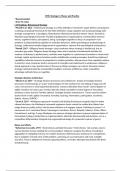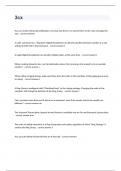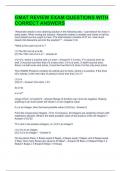MT8: Strategy in Theory and Practice
*Recommended
~from Y1 notes
L15 Readings- Behavioural Strategy
*Powell et al. 2011- <behavioural strategy as a field, definition, framework> paper defines and proposes
a unifying conceptual framework for the field. Definition: merge cognitive and social psychology with
strategic management. 3 paradigms: Reductionism (behavioural decision theory- biases, heuristics),
Pluralism (psychological character of political judgements in organisations), Contextualism (schema
theory, cognitive frames, perceptions). Bring 3 paradigms together to focus on proposed 4 core
problems (scaling individual cognition to collective behaviour, define psychological underpinnings of
strategy, understand complex judgements in organisations, improve firm psychological architecture).
*Powell, 2017- <Diligence-based strategy> chess syndrome where strategy is intellectual, but an
execution gap exists. Diligence-based strategy: basic unit of analysis is fundamental activities (its
mastery contributes to performance), activities work together in a performance function to create total
strategic capital, performance function usually multiplicative meaning managers should have balanced
capabilities (allocate resources in proportion to relative priorities; allocate more if low capability relative
to priority), most companies tend to overinvest in strengths and underinvest in weaknesses. Diligence-
based approach is more practical since it focuses on things managers can control. Economics-based
strategy methods limited by social/political realities/ economic inefficiency, older competitive-
advantage methods focus on cognition.
Strategic decision architecture
*Sibony et al. 2017- <strategic decision processes and architecture> 3 types of strategic decision
processes: investment (go or no go? Control degree of risk; tendency for risk-seeking in large one-off
cases, risk aversion in small sequential decisions), resource allocation (How much? Control degree of
agility; tendency for status quo/ inertia), Blue Sky (what is possible? Control degree of innovation;
tendency to have too few/ familiar options). Strategic decision architecture's 7 levers used to achieve
desired level of risk/ agility/ innovation: formality, layering, information, participation, incentives,
debate, closure (FLIPIDC)
*Liu et al. 2017- <Mindspace approach> Instead of de-biasing (training to recognise bias) for better
rational decisions, the Mindspace framework engineers choice context to combat bias (taken from
nudge theory in public policy). May be more effective as it engages system 1 thinking vs system 2. A
mneumonic for 9 contextual forces: Messengers, Incentives, Norms, Defaults, Salience, Prime, Affect,
Commitment, and Ego. 3 ways Mindspace can improve strategic decisions: improve implementation of
formulated strategy (combat bias in implementation), eliminate behaviourally bad decisions, act as a
competitive differentiator (integrate into organisational design for systematic capture of gains)
Biases and effects
*Kahneman & Lovallo, 1993- <timid choices and bold forecasts> Timid choices: risk aversion, due to
narrow decision frames isolating the current problem, failing to recognise the effects of statistical
aggregation in mitigating risk (esp. for smaller decisions). Bold forecasts: tendency for overoptimism,
due to adoption of inside view of the problem, anchoring on successful plans and most available
scenarios. These 2 attitudes to risk have opposing effects, corrective attempts should deal with them
simultaneously.
, Can be used in M&A diversication questions alongside Hayward & Hambrick 1997 for
overpayment from estimation issues
*Zajac & Bazerman, 1991- <3 effects of not considering competitors decisions sufficiently> not
considering contingent decisions of competitors sufficiently (winner's curse, nonrational escalation of
commitment, overconfidence in judgement, limited frame). Leads to observed: industry overcapacity
(overconfidence in being the preempting firm), high new business entry failure (underestimate
competitor retaliation with limited frame/ overconfidence, escalation rather than withdrawal upon
retaliation), high acquisition premiums (overconfidence in ability for synergy generation, not realising
other bidders have similar mentality of having unique synergies).
~Kahneman, 2012- <thinking fast and slow>. System 1 is fast, instinctive and emotional; System 2 is
slower, more deliberative, and more logical. Heuristics and biases (anchoring, sunk cost, loss aversion,
framing)
Not important
*Bromiley, 2005- book
Wernerfelt & Karnani, 1987
*Felin 2014- <Manager as a choice architect in nudging> specifying the choice interface (menu,
structure, ordering of choices) available for employees could greatly impact employee welfare and
organisational performance. Paper focused on applications of nudging in hiring, training and
development, human capital and organization, and strategy and innovation.
Other decision architecture references are sufficient
*Chatterji et al. 2015- <strategy and process field experiments> use field research (experiments within a
firm) to complement observational empirical research. Advantages: good at assessing processes/
activities within firms that data sources provide little detail to, could answer questions otherwise hard to
address. Drawbacks: external validity and feasibility. Strategy field experiments (effect of strategic
choice X on firm performance Y). Process field experiments (test the theoretical mechanism
underpinning a causal relationship of interest)
L16 Readings- Strategy in Theory and Practice
*Bromiley & James-Wade, 2003- <Behavioural perspective in strategic management> rather than
rational theories implying no rules exist to outperform a market, a behavioural perspective where firms
make sub-optimal decisions is more useful. Under rational markets, high profits from: operating in less
competitive markets (Porter's 5 forces) or compete where abilities lie (RBV). Strategic decision making in
the behavioural perspective: look for riches (find tools that work and how long they will offer an
advantage before diffusing), look for market inefficiencies (competitive analysis at the product-market
level rather than business-unit level), managing knowledge transfer (keep good tool to yourself longer,
get others' good tools faster)
Other related
~Janis, 1972- <groupthink>, dangers of trading off intra-group conflict with optimal decision-making, Bay
of Pigs invasion
~Cyert et al, 1972- <The Carnegie School criticised classical rational models>. Fails to take account of
bounded rationality, irrational preferences, risk vs uncertainty
, ~Cohen et al., 1972 - “Garbage Can” model of decision-making with organized anarchies. Solutions
looking for issues, choices looking for problems, decision makers looking for work.
~Pfeffer & Sutton 2006- <evidence-based management> and obstacles to implementing it. Changes
power dynamics, unpleasant truths, messy and inefficient market for business ideas. Reengineering
consulting (incentive misalignment). Excessive focus on success stories.
Not important
~*Barney, 1986- <strategic factor markets> Superior returns from exploiting competitive imperfections
in strategic factor markets. Internal analysis of capabilities as key source of advantage in identifying
underpriced strategic factors for the company.
*Besanko, 2007- Book. Ch13
*Whittington et al. 2016- <strategy presentations by CEOs are not cheap talk> especially in cases of
information asymmetry and external (outside the firm) new CEOs, presentations are associated with
stock price increase (meaning they are viewed as credible, economically significant)
Examples/ Lecture
Optimism and overconfidence: high M&A premiums
Herd behaviour: VC investing FOMO
Status quo bias: polaroid not pursuing digital camera revolution
De-biasing in M&A:
o Firms can, for example, pre-commit to two defaults for all M&A deals:
At least three similar deals that failed should be presented
Every manager has to present a “pre-mortem” by first imagining that the deal
has failed and then working backward to determine what potentially could lead
to the failure.
o These techniques can break groupthink (norm) and remind people about the possible
losses (incentive) and attenuate the emotion associated with the fear of losing to
competitors (affect).
De-biasing in hiring:
o A leading law firm, Clifford Chance, adopted a “CV blind” policy to counter the Oxbridge
recruitment bias. By engineering the hiring context this way, the firm has managed to
find many “hidden gems” in the underexploited pool of graduates from non-elite
universities that their competitors were not considering
o The example of hiring against stereotype also highlights an enduring challenge for
strategists: a tension between ego and norms and the maximization of profit. To
enhance one’s ego, one often has to conform to the existing norms and to act in a
similar way to others.
o This is likely, for example, to lead one being viewed positively by colleagues and
stakeholders in the short term. Yet conformity with current norms often reduces the
likelihood of gaining competitive advantage, which requires acting differently
Will we see more controlled experiments in firm strategies? Is “experimental strategy” and
“evidence-based management” the next frontier?






